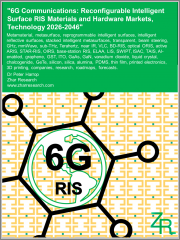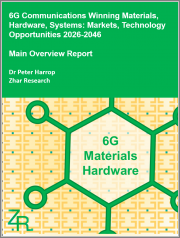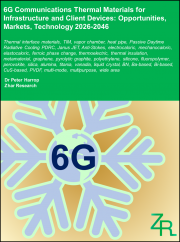
|
시장보고서
상품코드
1540729
6G 무선 기술용 반도체의 성장 기회Growth Opportunities in Semiconductors for 6G Wireless Technology |
||||||
AI 칩셋과 화합물 반도체는 차세대 셀룰러 무선 기술의 운영 및 경제적 목표를 가능하게 하는 혁신적인 역할을 할 것
무선 통신 시스템은 PA, LNA, 트랜시버(통칭 RF FEM)와 같은 반도체 부품에 의존하여 무선 유닛(RU), 베이스밴드 유닛(BBU), 네트워크 코어와 신호를 처리하여 고객이 데이터 및 서비스를 전송하는 무선 신호를 데이터와 서비스를 전송하는 무선 신호를 안정적으로 수신할 수 있도록 합니다.
통신 시스템은 안테나 집적회로(IC), 엔벨로프 트래커, 마이크로프로세서, 아날로그 장치, 광학 부품과 같은 다른 반도체 부품에 의존하여 필요한 신호를 처리합니다. 무선 통신이 사용하는 반도체 종류는 2G에서 5G로 기술이 발전해도 크게 달라지지 않았습니다. 하지만 반도체 부품에 요구되는 성능은 향상되고 있습니다. 따라서 설계, 재료, 제조, 패키징 기술은 새로운 세대의 무선 통신이 등장할 때마다 진화하고 있습니다.
5G 무선 기술이 전개 단계에 있기 때문에 업계 리더들은 차세대 무선기술(6G) 개발에 대한 논의를 시작했으며, 2030년에 조기 상용화를 시작할 예정이며, 6G의 개막은 데이터를 넘어 새로운 서비스를 제공하는 새로운 통신시대를 의미합니다. 이 조사는 에지에서의 분산 학습과 연합 학습, 에지와 코어 간의 공동 추론, 엔드 디바이스의 자율 기능, AI를 활용한 인간 중심 통신 서비스 개발, 공동 통신, 컴퓨팅, 센싱, 제어 및 기타 여러 개념에 대해 논의하고 있으며, 이는 무선 액세스 네트워크(RAN) 아키텍처에서 서비스로의 전환을 의미합니다.
6G를 개발하기 위해 업계 이해관계자들은 차세대 무선 기술 개발로 이어질 각 하위 기술의 구성요소와 빌딩 블록을 계획하기 위해 협력하고 있습니다. 이해관계자들의 초기 논의에 따르면, 고속 데이터 전송을 가능하게 하고 고주파수에서 작동하기 위해서는 (컴퓨팅 및 RF에서) 고성능 기능을 갖춘 첨단 반도체가 필요하다는 데에 공감대를 형성하고 있습니다.
목차
전략적 원칙
- 왜 성장이 어려워지는가?
- The Strategic Imperative 8(TM)
- 6G용 반도체 업계에 대한 주요 전략적 원칙의 영향
- Growth Pipeline Engine(TM)을 촉진하는 성장 기회
6G용 반도체 성장 기회 분석 - 6G 개요
- 주요 조사 결과
- 분석 범위
- 6G - 셀룰러의 진화 개요와 원하는 6G 네트워크 특성
- 왜 6G인가? 왜 지금인가?
- 6G의 상용화를 위한 로드맵
- 6G - 통합 기술 로드맵
- 성장 촉진요인
- 성장 억제요인
- 6G 생태계
6G용 반도체 성장 기회 분석 - AI 프로세서 반도체
- AI 프로세서가 6G에 필수적인 이유
- 통신의 미래를 위해 RAN에 AI를 통합 - ORAN 인프라
- 6G 네트워크 인프라의 AI - AI-RAN의 대두
- 엣지 컴퓨팅
- 6G의 엣지 AI - 잠재적 애플리케이션 유니버스
- 6G 네트워크에서 엣지 AI 칩셋의 주요 중점 분야
- 6G 요건을 평가하기 위한 현행 프로세서 이해 - 주요 기업과 제품
- 6G의 AI - 컴퓨팅 퍼포먼스 요건 결정 방법
- 실리콘 포토닉스(SiPh) 도래
- 6G 네트워킹용 AI 반도체의 지역 경쟁력
- 6G 기술을 실현시키기 위한 주목할 만한 개발, 이니셔티브, 활동, 협업
- AI에 대한 반도체 기업의 주목할 만한 투자
- 6G용 A I반도체 생태계
- 향후 5년까지 기대되는 연구 활동
- 6G의 AI - 사이버 보안과 지속가능성의 중요성
6G용 반도체 성장 기회 - RF 반도체
성장 기회 유니버스 - 6G 연구 이니셔티브, 지역별
성장 기회 유니버스 - 6G용 반도체에 필수적인 주요 애플리케이션과 그 배경
- 6G용 반도체 - 기회 배경, 주요 용도별 : AV·스마트 매뉴팩처링
- 6G용 반도체 - 기회 배경, 주요 용도별 : 헬스케어·스마트 시티
- 애플리케이션 프로파일 - 산업 메타버스
- 애플리케이션 프로파일 - 모빌리티
성장 기회 유니버스
- 성장 기회 1 - 코어 및 엣지에서의 인지 지능
- 성장 기회 2 - 애플리케이션 고유의 칩셋
- 성장 기회 3 - 정부 자금과 정책 활용
- 자료 리스트
- 면책사항
AI Chipsets and Compound Semiconductors Will Play a Transformational Role, Enabling the Operational and Economic Targets of Next-gen Cellular Wireless Technology
Wireless communication systems rely on semiconductor components, such as PAs, LNAs, and transceivers (together known as RF FEMs), to process signals to and from the radio unit (RU), baseband unit (BBU), and the network core to ensure customers receive the radio signals that carry the data and services.
The communication system relies on other semiconductor components, such as antenna integrated circuits (ICs), envelope trackers, microprocessors, analog devices, and optical components, to process signals as necessary. The type of semiconductors that wireless telecom communication uses has not changed much with the 2G to 5G evolution of technologies. However, the semiconductor components' performance requirements have increased. Hence, the designs, materials, manufacturing, and packaging technologies have evolved with each new wireless communication generation.
Because 5G wireless technology is in the deployment stage, industry leaders have begun discussions about developing the next-gen wireless technology (6G) and plan to begin early commercialization in 2030. The dawn of 6G will represent a new era of communication that will provide new services beyond data. The study discusses distributed and federated learning at the edge, co-inferencing between edge and core, autonomous functioning of end devices, the development of AI-powered human-centric telecom services, joint communication, computing, sensing, and control, and several other concepts, which represent a transformation from radio access network (RAN) architecture to services.
To develop 6G, industry stakeholders are collaborating to plan the components and building blocks of each sub-technology that will lead to the development of the next-gen wireless technology. Initial stakeholder discussions are leading to an understanding that advanced semiconductors with high-performance capabilities (in computing and RF) will be necessary to enable high-speed data transfer and operate at high frequencies.
- This analysis aims to understand the changes expected in 6G wireless communication from a context of the semiconductor industry, with specific focus on RAN, and the edge.
- From a component perspective, the analysis focuses on the AI-processors, and the key RF components required at the network RAN and the edge.
- The analysis does not cover the changes expected in discrete, analog, memory, optical, and sensing products.
- It aims to provide a qualitative view based on the developments during the study period and is subject to change in the future.
- It does not aim to provide a quantitative overview of the market potential.
Table of Contents
Strategic Imperatives
- Why is it Increasingly Difficult to Grow?
- The Strategic Imperative 8™
- The Impact of the Top 3 Strategic Imperatives on the 6G Semiconductors Industry
- Growth Opportunities Fuel the Growth Pipeline Engine™
Growth Opportunity Analysis in Semiconductors for 6G-6G Overview
- Primary Findings
- Scope of Analysis
- 6G-Overview of Cellular Evolution and Desired 6G Network Characteristics
- Why 6G? Why Now?
- 6G Roadmap to Commercialization
- 6G-Integrated Technology Roadmap
- Growth Drivers
- Growth Restraints
- 6G Ecosystem
Growth Opportunity Analysis in Semiconductors for 6G-AI-Processor Semiconductors
- Why are AI Processors Critical for 6G?
- Infusing AI into RAN for the Future of Telecom-Open Radio Access Network (ORAN) Infrastructure
- AI in 6G Network Infrastructure-Emergence of AI-RAN
- Edge Computing
- Edge AI in 6G-Potential Application Universe
- Primary Focus Areas for Edge AI Chipsets in the 6G Network
- Understanding Current Processors to Evaluate 6G Requirements- Primary Companies and Products
- AI in 6G-How to Determine Compute Performance Requirements
- The Coming of Silicon Photonics (SiPh)
- Regional Competency of AI Semiconductors for 6G Networking
- Notable Developments, Initiatives, Activities, and Collaborations to Realize 6G Technology
- Notable Investments in AI by Semiconductor Companies
- The AI-Semiconductor Ecosystem for 6G
- Expected Research Efforts in the Next 5 Years
- AI in 6G-The Significance of Cybersecurity and Sustainability
6G Semiconductor Growth Opportunity-RF Semiconductors
- RF Semiconductors in 6G-Enabling 100 GHz and Higher Operational Frequencies
- RF Semiconductors in 6G-Process Node Trajectory
- RF Semiconductors in 6G-Exploring Materials Beyond Si
- RF Semiconductors in 6G-Exploring Materials Beyond Si: GaN
- RF Semiconductors in 6G-Exploring Materials Beyond Si: InP
- RF Semiconductors in 6G-Advanced Packaging Technologies
- RF Semiconductors in 6G-GaN and InP Gaining R&D Traction for Application in Next-gen Wireless Technology
- RF in 6G-Primary Products Enabling the Research and Development of 6G
- RF in 6G Investments and R&D Initiatives that Semiconductor Companies Have Announced
- RF in 6G-Primary Regional Initiatives and Investments
- RF in 6G-Ultra-wide Bandgap (UWBG) Semiconductors
- The AI Semiconductor Ecosystem in 6G
Growth Opportunity Universe-6G Research Initiatives by Region
- 6G Research and Collaboration Initiatives by Primary Regions
- 6G Patent Applications by Region (2019-2021)
Growth Opportunity Universe-Key Applications and Context of the imperative for 6G Semiconductors
- Semiconductors for 6G-Context of Opportunities by Primary Applications: AVs and Smart Manufacturing
- Semiconductors for 6G-Context of Opportunity by Primary Applications: Healthcare and Smart Cities
- Application Profile-Industry Metaverse
- Application Profile-Mobility
Growth Opportunity Universe
- Growth Opportunity 1-Cognitive Intelligence at the Core and Edge
- Growth Opportunity 2-Application-specific Chipsets
- Growth Opportunity 3-Leverage Government Funding and Policies
- List of Exhibits
- Legal Disclaimer



















